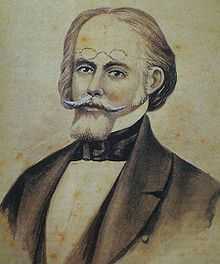Simón Rodríguez
| Simón Rodríguez | |
|---|---|
 Simón Rodríguez, known during his exile from Spanish America as Samuel Robinson | |
| Born |
October 28, 1769 Caracas, Venezuela |
| Died |
February 28, 1854 (aged 84) Amotape, Perú |
| Signature |
 |
Simón Rodríguez (Caracas, Venezuela, October 28, 1769 – Amotape, Perú, February 28, 1854), known during his exile from Spanish America as Samuel Robinson, was a South American philosopher and educator, notably Simón Bolívar's tutor and mentor.
His mother, Rosalia Rodríguez, was the daughter of an owner of farms and livestock; her father was originally from the Canary Islands.[1] In May 1791, the Caracas Council (Cabildo) gave him a position as teacher in the "Reading and Writing School for Children". In 1794, he presented his critical writing Reflection on the flaws vitiating the Reading and Writing School for Children in Caracas and Means of Achieving its Reform and a New Establishment to the council. It's an original approach to a modern school system.
His role in the failed Gual and España conspiracy against the Spanish crown in 1797 forced him to leave Venezuela.
In Kingston, Jamaica he changed his name to Samuel Robinson, and after staying some years in the United States he traveled to France (1801). There, in 1804, he met his former tutee, Simón Bolivar; together they made a long journey across Europe. They witnessed the coronation of Napoleon Bonaparte in Milan, as King of Italy and in Rome, witnessed how Bolívar took his famous oath that he would liberate all of America from the Spanish Crown, and registered it for history: "I swear before you; I swear on my parent’s God; I swear on them; I swear on my honor; and I swear on my Motherland; that I won’t give rest to my arm, nor repose to my soul, until I have broken the chains that oppress us by will of the Spanish power."
Between 1806 and 1823, Rodríguez lived in Italy, Germany, Prussia, Poland and Russia. He would later say of this time: "I stayed in Europe for more than twenty years; I worked in an Industrial Chemistry Laboratory [...] attended some secret socialist-oriented meetings [...] studied a little literature; learned languages and directed a Reading and Writing School in a small Russian town".
Rodríguez returned to America in 1823, using his name "Simón Rodríguez" again. In Colombia he established the first workshop-school in 1824. He was called to Peru by Simón Bolívar and became "Director for Public Education, Physical and Mathematical Sciences and Arts" and "Director of Mines, Agriculture and Public Roads" of Bolivia.
In 1826, Rodríguez established a second workshop-school, as part of a project for all Bolivia. But Antonio José de Sucre, president of Bolivia since October 1826, did not have a good relationship with him, and Rodríguez resigned the same year, working during the rest of his life as educator and writer, living alternatively in different places of Peru, Chile and Ecuador. Very important is his work Sociedades Americanas (American Societies), which was divided in several issues published in Arequipa in 1828, in Concepción in 1834, Valparaíso in 1838 and Lima, in 1842.
Most of Rodríguez' written work remained in Guayaquil, Ecuador, but were sadly lost in the large city fire of 1896.
Rodriguez is the face on the 50 Bolivar Fuerte bills. He was also the face in the old 20,000 Bolívar bills (until 2007). One of the Bolivarian Missions of Hugo Chávez, Mission Robinson, is named for him.
References
- ↑ Juan Medina Figueredo (2001), "SIMÓN RODRÍGUEZ: PINCELADAS PARA UN RETRATO"
- Consuelo Hernández. "Simón Rodríguez y la crítica." El Nacional. August 7. 1982
- Consuelo Hernández."Simón Rodríguez visto en la perspectiva del tiempo." Revista de la Universidad Simón Rodríguez. Año III. No. 4, 1982. pp. 21–33.
External links
- (Spanish) Simón Rodríguez' Work, Sociedades Americanas (American Societies)
- (Spanish) Glrbv.org.ve
| ||||||||||||||||||||||||||||||||||||||||
|